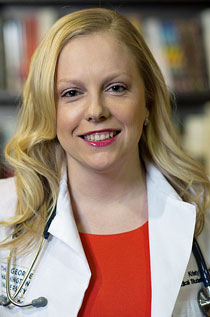 My name is Dr. Kristy Hawley, I am a third year surgical resident in the MedStar Health Baltimore program. I have been an active member and participant in Benjamin Rush Institute (BRI) activities since my first year of medical school at The George Washington School of Medicine and Health Sciences. I was recently asked to give some background on how our paper, The Impact of Price Transparency for Surgical Services, recently published in The American Surgeon on price transparency for surgical services came about.
My name is Dr. Kristy Hawley, I am a third year surgical resident in the MedStar Health Baltimore program. I have been an active member and participant in Benjamin Rush Institute (BRI) activities since my first year of medical school at The George Washington School of Medicine and Health Sciences. I was recently asked to give some background on how our paper, The Impact of Price Transparency for Surgical Services, recently published in The American Surgeon on price transparency for surgical services came about.
I attended the Free Market Medical Association conference in 2015 as a medical student with the assistance of a BRI scholarship. At this meeting I had the opportunity to tour the Surgery Center of Oklahoma and spend time with Dr. Keith Smith discussing his journey in setting up his very successful and press-worthy surgery center. The unique aspect of the Surgery Center of Oklahoma is that it is completely transparent with its pricing. It was interesting to hear that when trying to determine prices for the operations many of the surgeons actually underestimated their worth. The final list of prices has been quite affordable for patients and the surgeons and anesthesiologists have been quite pleased with their compensation. The Surgery Center of Oklahoma now competes significantly in its local market for surgical patients because it offers transparent pricing, high quality care and high level of patient satisfaction. While I am always a proponent of price transparency, something incredibly unique about this place is that the surgeons, anesthesiologists, and nursing and OR staff seemed very satisfied with their jobs. While they were being fairly compensated, they also had ease with booking cases and were working in a very efficient environment, which allows for more time outside of the OR for outside work or leisu
The leading barrier reported to making prices transparent was discouragement from another practice, hospital, or insurance company.” ~Kristy L. Hawley, MD MPH

The press covered the success of the Surgery Center of Oklahoma in the early 2010s when giving examples of free market solutions versus the Affordable Care Act which was government funded and driven. In 2009 the Surgery Center of Oklahoma posted a list of prices for 112 common surgical procedures online. The premise behind the Surgery Center of Oklahoma is that making prices transparent while also delivering high quality care makes healthcare more affordable to the average American. One article gave the example of an uninsured Florida woman who paid $10,800 for a hysterectomy at the Surgery Center of Oklahoma versus $33,000 quoted by hospitals in Florida. The success of the Surgery Center of Oklahoma inevitably led me to think how useful it would be to share the story of this center beyond stories from the press. After attending the conference in 2015, I connected with Dr. Marty Makary, a pancreatic surgeon at Johns Hopkins who advocates for more transparency in healthcare; and we decided to attempt a survey of surgery centers that have made their surgery prices transparent. We hoped to determine whether or not making prices transparent had an impact on their bottom line and whether or not there were higher levels of patient and physician satisfaction.
While increasing insurance deductibles have prompted some medical centers to initiate transparent pricing, the actual impact of price transparency on surgical volume, revenue, and patient satisfaction is unknown. We found limited information on the barriers to achieving a business model with transparent pricing. Dr. Makary, along with Dr. Ambar Mehta, Tim Xu and Ge Bai from Johns Hopkins, and I worked together to devise a survey that would give some insight into these questions.
We identified ambulatory surgical centers in the Free Market Medical Association database that publicly list prices for surgical services online. Six of eight centers (75%) responded to our data collection inquiry.
- Among five centers that reported their patient volume and revenue after adopting price transparency, patient volume increased by a median of 50 per cent (range 10–200%) at one year.
- Four centers (80%) reported an increase in revenue by a median of 30 per cent (range 4–75%)
- Three centers (60%) experienced an increase in third-party administrator contracts with the average increase being seven new third-party administrator contracts (range 5 2–12 contracts).
- There were three centers (50%) that reported a reduction in their administrative burden, and
- Five centers (83%) reported an increase in patient satisfaction and patient engagement after price transparency.
The leading barrier reported to making prices transparent was discouragement from another practice, hospital, or insurance company. The findings of this preliminary study may help guide medical practices in designing and implementing price transparency strategies.
I share this background on my participation in this recent study to advocate for medical students to get involved in the BRI. The networking opportunities are extremely valuable in terms of finding like-minded individuals who may be interested in topics related to free market medicine and protecting the doctor-patient relationship from overregulation by government interest. My participation in this conference enabled me to make the connection with Dr. Smith and see first-hand a highly functioning outpatient surgical center with transparent pricing. The high level of physician and patient satisfaction at this center is what prompted the idea for the survey. I continue to be interested in the impact of price transparency on lowering costs and increasing quality in patient care and as a surgical resident it will most certainly influence my career as a surgeon.
